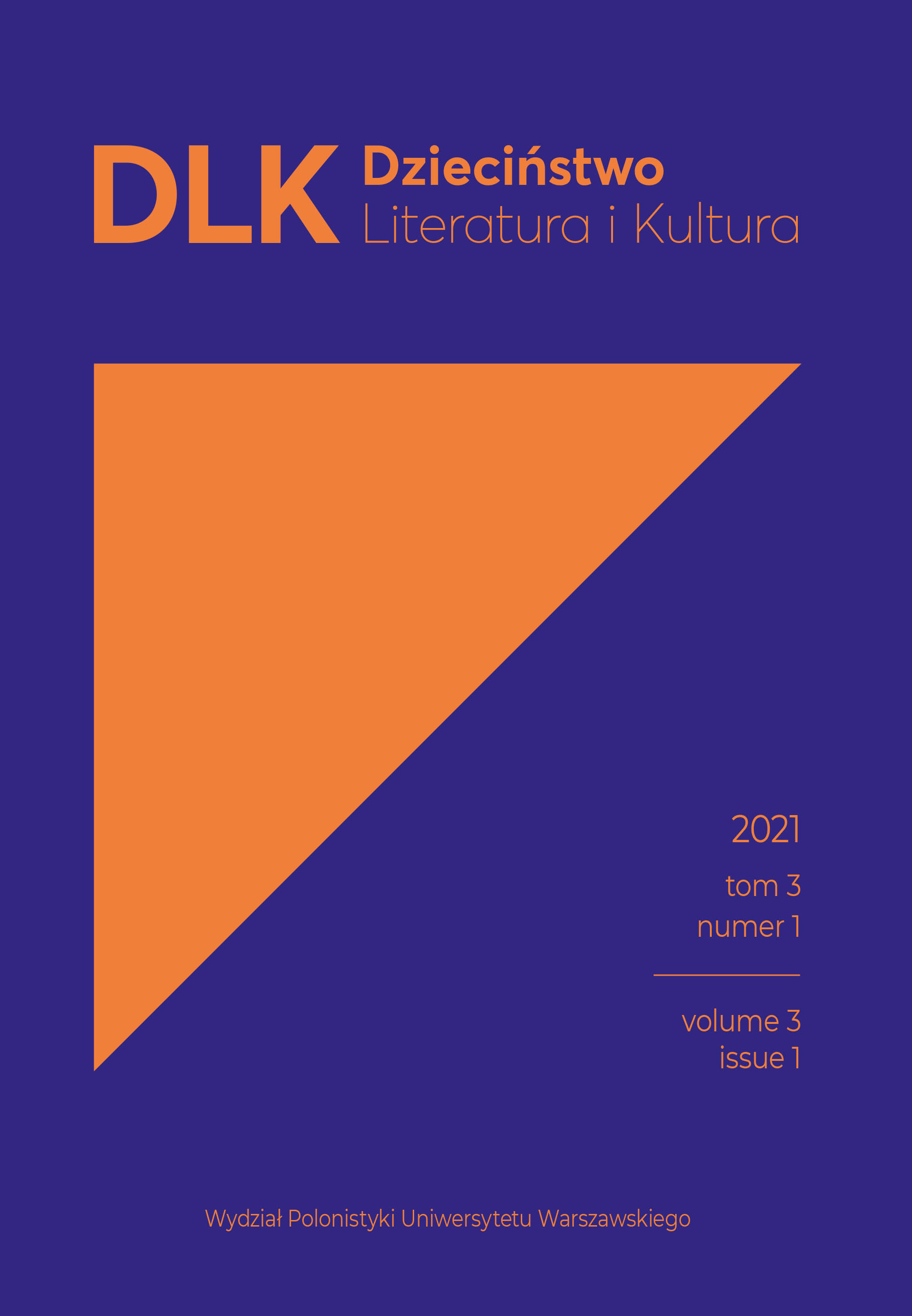The Devil is in the Details, or the Question of Literary Value of Children’s Literature in Translation (Based on the Books by Ulrich Hub and Wolf Erlrbruch)
Abstract
The paper discusses the question whether children’s literature can render its aesthetic dimensions in translation. When children’s books are treated solely as tools for education or entertainment, they often lose their artistic features in translation. Two contemporary German books – Ulrich Hub’s An der Arche um Acht [Meet at the Ark at Eight] (2007) and Wolf Erlbruch’s Die fürchterlichen Fünf [The Fearsome Five] (1990) – and their Polish translations are examined with reference to their aesthetic values such as humour, repetitions, puns, and contrast between different language styles. Based on this analysis, it can be said that many so-called untranslatable features of a literary work can be rendered in translation allowing target readers to experience emotions like those of original readers.
Received: 30.01.2022
Accepted: 25.03.2022
Keywords
German children’s literature; Meet at the Ark at Eight; literary translation; The Fearsome Five; children’s literature translation studies; Ulrich Hub; Wolf Erlbruch
References
Albińska, K. (2009–2010). „Tylko to, co najlepsze, jest dość dobre dla dzieci”, czyli o dylematach tłumacza literatury dziecięcej. Przekładaniec, 22–23(2–1), 259–282.
Barańczak, S. (1984). Poetycki model świata a problemy przekładu artystycznego (na materiale polskich tłumaczeń G. M. Hopkinsa). W: E. Balcerzan (red.), Wielojęzyczność literatury i problemy przekładu literackiego (s. 207–226). Zakład Narodowy im. Ossolińskich.
Barańczak, S. (1992). Ocalone w tłumaczeniu. Szkice o warsztacie tłumacza poezji z dołączeniem małej antologii przekładów. Wydawnictwo a5.
Bednarczyk, A. (2008). W poszukiwaniu dominanty translatorskiej. PWN.
Borodo, M. (2011). The regime of the adult: Textual manipulations in translated, hybrid, and glocal texts for young readers. W: A. Duszak, U. Okulska (red.), Language, culture and the dynamics of age (s. 329–347). Mouton.
Brzozowski, J. (2011). Stanąć po stronie tłumacza. Zarys poetyki opisowej przekładu. Wydawnictwo UJ.
Czernow, A., Michułka, D. (2017). Historical twists and turns in the Polish canon of children’s literature. W: B. Kümmerling-Meibauer, A. Muller (red.), Canon constitution and canon change in children’s literature (s. 84–104). Routledge.
Dybiec-Gajer, J. (2017). Złota różdżka – od książki dla dzieci po dreszczowiec raczej dla dorosłych. Tertium.
Erlbruch, W. (1990). Die fürchterlichen Fünf. Peter Hammer.
Erlbruch, W. (2007). Straszna piątka (tłum. Ł. Żebrowski). Hokus-Pokus. (wyd. oryg. 1990).
Ewers, H.-H. (2012). Literatur für Kinder und Jugendliche. Eine Einführung. Wilhelm Fink.
Ewers, H.-H. (2022). Theorie der kinder- und jugendliterarischen Kommunikation. Eine Grundlegung. Schwabe.
Goethe-Institut Polen. (2011). Rozmowy z tłumaczami: Anna Gamroth. Pobrane 17 czerwca 2022 z: https://www.goethe.de/ins/pl/pl/kul/dos/ueb/ges/20554129.html.
Hejwowski, K. (2005). Kognitywno-komunikacyjna teoria przekładu. PWN.
Hub, U. (2010). O ósmej na arce (tłum. A. Gamroth). Media Rodzina. (wyd. oryg. 2007).
Hub, U. (2013). An der Arche um Acht. Fischer Taschenbuch. (wyd. oryg. 2007).
Hub, U. (2021). O ósmej na arce (tłum. A. Gamroth). Dwie Siostry. (wyd. oryg. 2007).
Klingberg, G. (1978). Children’s books in translation: The situation and the problems. Almqvist & Wiksell.
Klingberg, G. (1986). Children’s fiction in the hands of the translators. CWK Gleerup.
Lathey, G. (2010). The role of translators in children’s literature: Invisible storytellers. Routledge.
Leszczyński, G. (2015). Wielkie małe książki. Lektury dzieci. I nie tylko. Media Rodzina.
Loba, A. (2020). Das seltsame Schicksal zweier rothaariger Mädchen: Die französische Übersetzung und Rezeption von Pippi Langstrumpf und Anne vom grünen Hügel. W: B. Sommerfeld, E. Pieciul-Karmińska, M. Düring (red.), Kulturelle Diversität in der Kinder- und Jugendliteratur (s. 169–182). Peter Lang.
O’Sullivan, E. (2000). Kinderliterarische Komparatistik. Universitätsverlag Winter.
Pieciul, E. (2005). Czy tłumacz musi znać teologię? Obraz niemieckiego katolicyzmu w polskim przekładzie Zwierzeń klowna Heinricha Bölla. W: M. Piotrowska (red.), Język trzeciego tysiąclecia. T. 2: Konteksty przekładowe (s. 55–62). Tertium.
Pieciul-Karmińska, E. (2013). „Niebieska broda”, czyli dlaczego nie należy tłumaczyć baśni braci Grimm z języka rosyjskiego. Język – Komunikacja – Informacja, 8, 58–77.
Pieciul-Karmińska, E. (2014). Polska seria przekładowa Dziadka do Orzechów i Króla Myszy E. T. A. Hoffmanna. Studia Interkulturowe Europy Środkowo-Wschodniej, 8, 56–87.
Pieciul-Karmińska, E. (2017). Proza Paula Maara a jej przekład na język polski w kontekście intertekstualnego motywu „tajemniczego dziecka”. W: E. Pieciul-Karmiń¬ska, B. Sommerfeld, A. Fimiak-Chwiłkowska (red.), Przekład literatury dla dzieci – między manipulacją a autonomicznością estetyczną (s. 13–46). WN UAM.
Reiss, K. (1971). Möglichkeiten und Grenzen der Übersetzungskritik. Max Hueber.
Reiss, K. (1982). Zur Übersetzung von Kinder- und Jugendbüchern. Theorie und Praxis. Lebende Sprachen, 27, 7–13.
Shavit, Z. (1986). Poetics of children’s literature. University of Georgia Press.
Sochańska, B. (2009–2010). Czy potrzebny był nowy przekład baśni Andersena?. Przekładaniec, 22–23(2–1), 97–129.
Sommerfeld, B. (2017). Z romantyzmem albo bez niego – o niektórych polskich i niemieckich przekładach Le petit prince Antoine’a de Saint-Exupéry’ego. W: E. Pieciul-Karmińska, B. Sommerfeld, A. Fimiak-Chwiłkowska (red.), Przekład literatu¬ry dla dzieci – między manipulacją a autonomicznością estetyczną (s. 47–86). WN UAM.
Stolt, B. (2006). How Emil becomes Michel: On the translation of children’s books. W: G. Lathey (red.), The translation of children’s literature: A reader (s. 67–83). Mul¬tilingual Matters.
Tabbert, R. (2002). Approaches to the translation of children’s literature: A review of critical studies since 1960. Target, 14(2), 303–351. https://doi.org/10.1075/target.14.2.06tab.
Woźniak, M. (2009–2010). Jak to z Kotem w butach było. Baśnie Charles’a Perraulta w przekładzie i adaptacji Hanny Januszewskiej. Przekładaniec, 22–23(2–1), 59–79.
Adam Mickiewicz University in Poznań Poland
https://orcid.org/0000-0002-6268-9873
Eliza Pieciul-Karmińska – PhD, professor at the Insitute of Applied Linguistics of the Faculty of Modern Languages and Literatures at the Adam Mickiewicz University (Poland). Her research interests include children’s literature translation studies and reception of the Grimm brothers’ tales. Contact: eliza.karminska@amu.edu.pl.

This work is licensed under a Creative Commons Attribution 4.0 International License.
Open Access Policy
All articles presented on the pages of ”Dzieciństwo. Literatura i Kultura” are published in open access under a Creative Commons license - Attribution 4.0 International (CC BY 4.0). It means that:
- they can be made available and quoted under the condition of explicit and clear indication of the author/authors of the referenced text;
- you cannot use legal or technological means that would limit others in using the text under the terms of the license.
More information: https://creativecommons.org/licenses/by/4.0/





